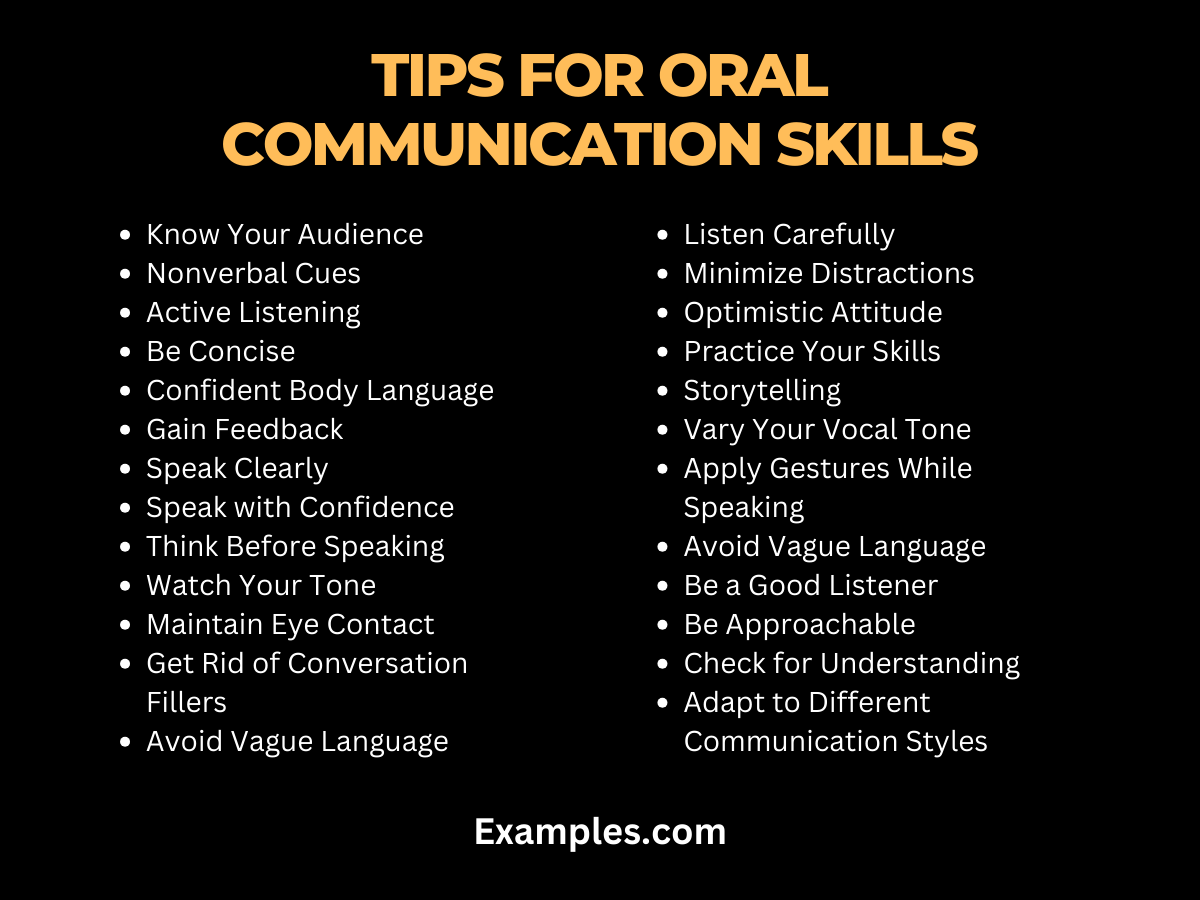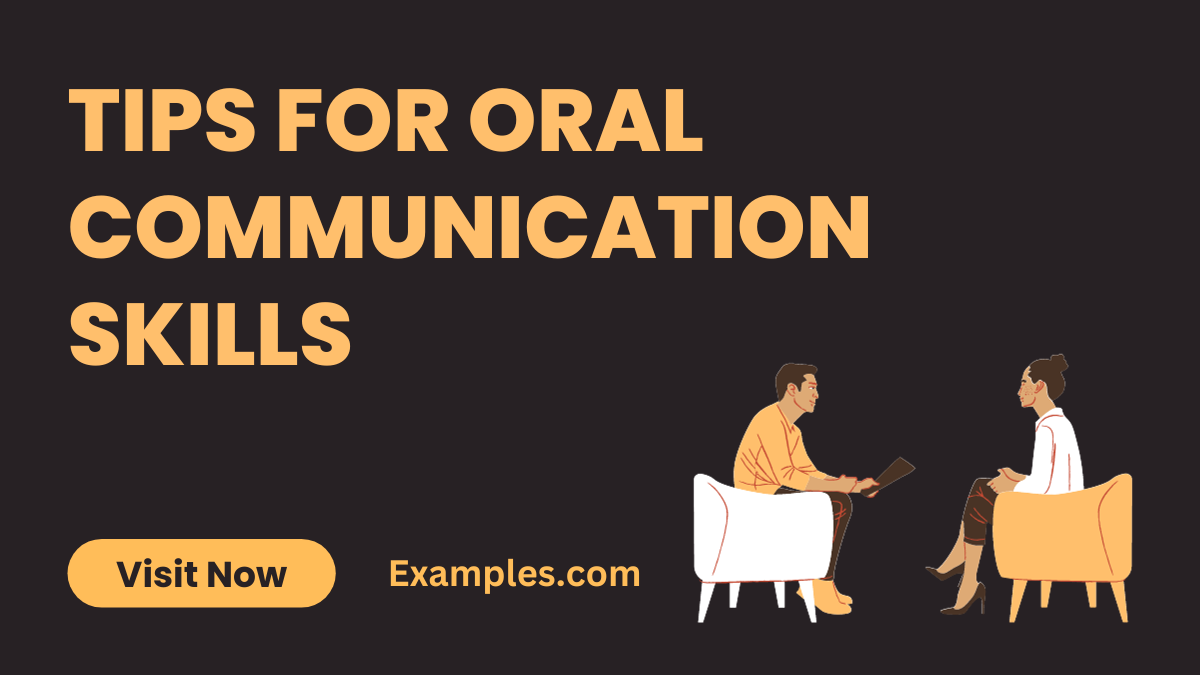Tips for Oral Communication Skills
Oral communication skills are pivotal in both personal and professional realms. This comprehensive guide delves into practical tips and strategies to enhance your speaking abilities. From mastering active listening to understanding the nuances of body language, you’ll discover how to convey your messages clearly and effectively. Whether it’s in a boardroom, classroom, or casual conversation, the ability to communicate orally is a valuable skill. This guide, enriched with real-world examples, offers a pathway to become a more confident and effective communicator.
25 Tips for Using Oral Communication Skills

Oral communication is an art that can be mastered with practice and awareness. This offers key tips to enhance your oral communication skills. From understanding nonverbal cues to employing active listening, each tip is designed to help you communicate more effectively. Whether you’re presenting in a meeting or engaging in casual conversation, these tips will aid in developing clarity, confidence, and connectivity with your audience.
- Know Your Audience: Tailor your message to resonate with the listeners.Understanding your audience is crucial for effective communication. It involves analyzing their interests, expectations, and level of understanding. Tailoring your message to their specific needs ensures it resonates and achieves the desired impact.
Example: “In a meeting with tech experts, I focus on technical details rather than basic concepts.” - Nonverbal Cues: Pay attention to body language and facial expressions.Nonverbal communication plays a significant role in conveying your message. It includes facial expressions, gestures, and body language. Being aware of and controlling these cues can greatly enhance the effectiveness of your oral communication.
Example: “When I see nodding heads, I know my message is being well-received.” - Active Listening: Show engagement and understanding.Active listening is key to effective oral communication. It involves fully concentrating, understanding, responding, and then remembering what is being said. This skill is vital for meaningful interactions and ensuring mutual understanding.
Example: “I nod and say, ‘I see your point,’ to indicate I am actively listening.” - Be Concise: Deliver your message clearly and briefly.Clarity and brevity are important in oral communication. Being concise helps in delivering your message effectively without losing the interest of your audience. It ensures that the core of the message is conveyed without unnecessary details.
Example: “In emails, I stick to one topic per paragraph for clarity.” - Confident Body Language: Stand tall and maintain an open posture.Your body language reflects your confidence and can influence how your message is received. Maintaining positive body language, like an upright posture and open gestures, can enhance your credibility and engagement with the audience.
Example: “I keep my shoulders back and chin up during presentations for confidence.” - Gain Feedback: Encourage and accept constructive feedback.Feedback is essential for improving communication skills. It involves seeking and responding to others’ reactions to your message. Constructive feedback helps in identifying areas for improvement and refining communication techniques.
Example: “After speaking, I ask, ‘How could I have expressed that more clearly?'” - Speak Clearly: Enunciate your words and pace your speech.Speaking clearly and articulately is vital for effective communication. It involves proper enunciation, appropriate speed, and clear articulation of words, ensuring that your message is easily understood.
Example: “I practice speaking slowly and clearly, especially during presentations.” - Speak with Confidence: Believe in what you’re saying.Confidence in speaking influences how your message is perceived. Speaking with assurance demonstrates your belief in the message, making it more convincing and impactful.
Example: “I use phrases like ‘I am confident that…’ to convey assurance.” - Think Before Speaking: Organize your thoughts first.Thoughtful speaking involves organizing your thoughts before verbalizing them. It helps in delivering a coherent and structured message, reducing misunderstandings and enhancing clarity.
Example: “Before answering a question, I take a moment to gather my thoughts.” - Watch Your Tone: Ensure your tone matches your message.The tone of your voice conveys emotions and attitudes. Modulating your tone to suit the content and context of your message can greatly impact its effectiveness and the response of your audience.
Example: “When giving feedback, I use a supportive tone to avoid sounding critical.” - Maintain Eye Contact: Engage with your audience visually.Eye contact is a powerful nonverbal tool in oral communication. It establishes a connection with the audience, conveying sincerity and confidence. Maintaining appropriate eye contact enhances engagement and helps in holding the attention of listeners.
Example: “I make eye contact with different people in the room while speaking.” - Get Rid of Conversation Fillers: Avoid ‘um’ and ‘ah.’Eliminating fillers like ‘um’ and ‘ah’ makes your speech more fluid and professional. It shows mastery over the language and aids in delivering a clear, uninterrupted message.
Example: “I pause instead of using fillers when I need a moment to think.” - Listen Carefully: Give full attention to the speaker.Effective communication is not just about speaking but also listening. Careful listening ensures you understand the context and respond appropriately, making the conversation more productive and meaningful.
Example: “In meetings, I focus entirely on the speaker, avoiding distractions.”

- Minimize Distractions: Create a conducive environment for communication.Minimizing external distractions enhances the quality of communication. It allows both the speaker and the listener to focus on the conversation, leading to better understanding and engagement.
Example: “I turn off notifications on my phone during important conversations.” - Optimistic Attitude: Keep a positive outlook in communication.Approaching conversations with optimism fosters a positive environment. It encourages open and constructive dialogue, making interactions more pleasant and effective.
Example: “I start conversations with positive news to set a friendly tone.” - Practice Your Skills: Regularly work on improving your communication.Like any other skill, oral communication improves with practice. Regularly engaging in speaking activities, seeking feedback, and reflecting on your performance can significantly enhance your communication abilities.
Example: “I join public speaking clubs to practice and refine my skills.” - Storytelling: Use stories to make your communication engaging.Incorporating storytelling in your communication makes it more engaging and memorable. Stories can illustrate points more effectively and create a stronger emotional connection with the audience.
Example: “I often start presentations with a relevant personal story.” - Vary Your Vocal Tone: Use inflections to keep the audience interested.Using different vocal tones adds interest and emphasis to your message. It helps in highlighting key points and keeps the audience engaged throughout the conversation.
Example: “I raise my tone slightly when I come to key points for emphasis.” - Apply Gestures While Speaking: Enhance your words with hand movements.Using hand gestures and body movements can emphasize and clarify your message. It makes your communication more dynamic and helps in conveying your message effectively.
Example: “I use hand gestures to emphasize important points in my speech.”

- Avoid Vague Language: Be specific and clear.Using specific and clear language avoids confusion and misinterpretation. It ensures that your message is understood as intended.
Example: “Instead of saying ‘soon,’ I give a specific time or date.” - Be a Good Listener: Show empathy and understanding.Being a good listener is as important as being a good speaker. It demonstrates respect and interest in others’ viewpoints, fostering more open and honest communication.
Example: “When someone is speaking, I show empathy by nodding and giving verbal acknowledgments.” - Be Approachable: Encourage open communication.An approachable demeanor encourages others to communicate openly with you. It creates a comfortable environment for exchange of ideas and information.
Example: “I start meetings with a warm smile to make everyone feel at ease.” - Be Authentic: Be true to yourself in your communication.Authenticity in communication builds trust and credibility. Being genuine in your interactions makes your message more relatable and convincing.
Example: “I share my genuine thoughts and feelings to create authentic connections.” - Check for Understanding: Confirm that your message is understood.Regularly checking for understanding ensures that your message is being correctly interpreted. It allows for immediate clarification of any misunderstandings, enhancing the effectiveness of the communication.
Example: “After explaining a concept, I ask, ‘Does that make sense to everyone?'” - Adapt to Different Communication Styles: Recognize and adjust to diverse styles.Recognizing and adapting to different communication styles is key to effective interaction. It shows respect for diversity and improves your ability to connect with a wide range of audiences.
Example: “With analytical audiences, I focus more on data and facts in my explanations.”
In conclusion, oral communication skills play a crucial role in both personal and professional settings. As the article on your website highlights, these skills encompass a range of practices from understanding body language to mastering active listening. However, to further enhance these skills, consider incorporating strategies from renowned sources.



